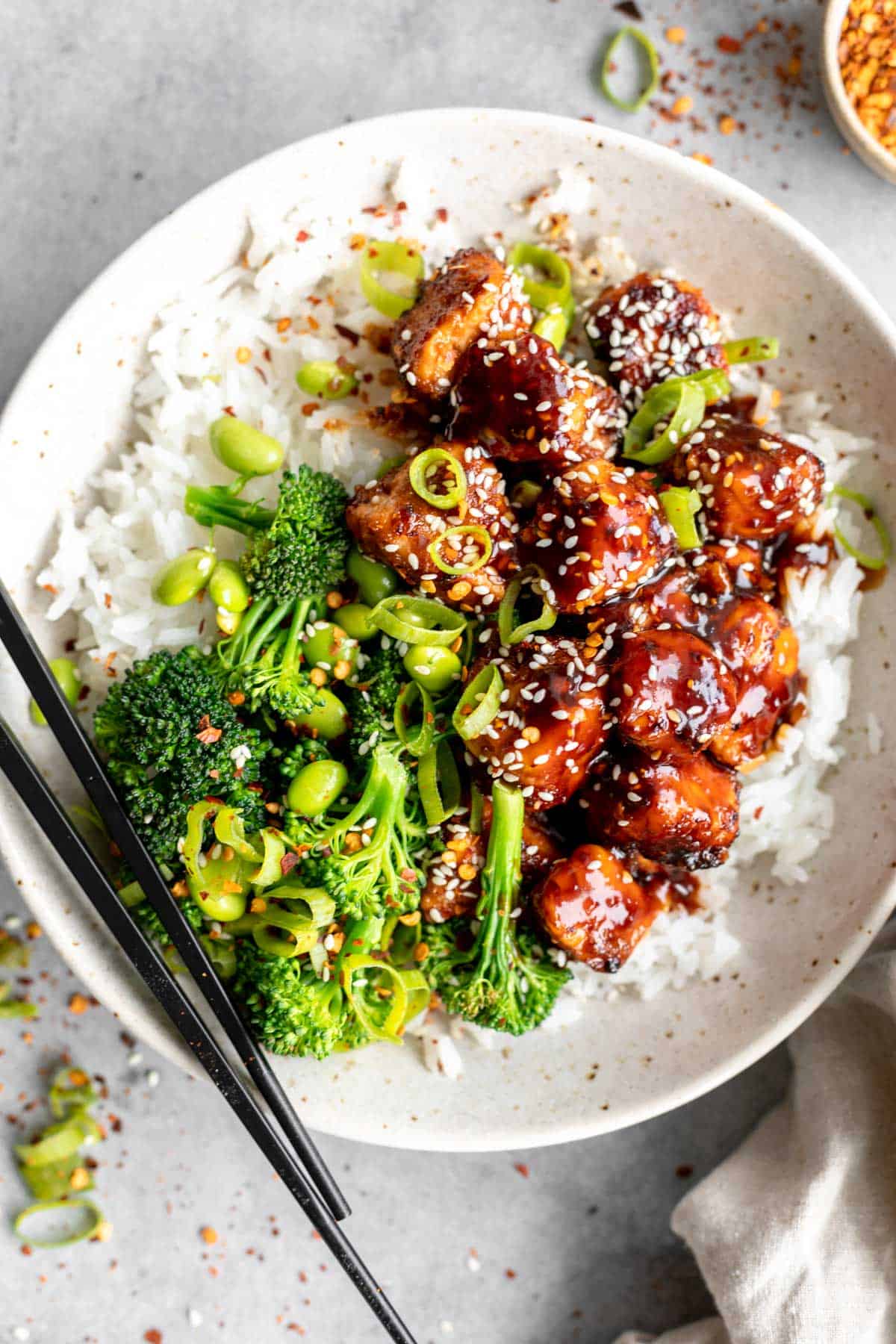Baked Teriyaki Salmon
BY: CLAIRE CARY eatwithclarity.com

Whisk together 1 tbsp of cornstarch and the water and set aside.
Add all other ingredients to a pot and bring to a low boil.
Whisk in the cornstarch mixture and let simmer over low heat until thick. Start with 1 tbsp cornstarch and add an additional 1/2 tbsp if the sauce isn't thickening properly.
It thickens more as it cools, so avoid adding too much too soon because you don't want it to get gloopy!
Whisk occasionally to prevent any clumps from forming.
NOTE: Once prepared, this sauce will store in the fridge for about 1 full week. Let it cool completely before transferring to an air tight jar or container.
I always use low sodium soy sauce because I find the regular stuff to be way too salty. You can use either, but regular may cause the sauce to be too salty since this was tested with low sodium. If you use regular, cut back by half.
Most teriyaki sauces use water instead of vegetable broth, but I’m big on flavor around here so I used vegetable broth. If you’re in a pinch and don’t have any, water will do! Chicken stock also works well!
If using previously frozen salmon, let defrost in the fridge overnight.
Preheat the oven to 400 degrees Fahrenheit.
Lightly oil the bottom of a baking dish to prevent any sticking.
Cut your salmon into one inch or so cubes. Cover with about half of the teriyaki sauce.
If you want to cook the filets whole and not cut into cubes, simply add the salmon, skin side down, with half of the teriyaki sauce. I like to use silicone brushes to spread it evenly on top.
If you're hungry and can't bother to let it marinate (I've been there!) then go ahead and pop it in the oven. Otherwise, allow the salmon to marinate for about 20 minutes to let it absorb some of the sauce.
Bake for 12-18 minutes (uncovered), depending on your preference and how thick the salmon fillets are. Cubed salmon will cook a bit faster, about 10-14 minutes depending on preference.
Check them at 10 minutes, they should easily flake with a fork and slide right off the skin. For the cubes, the color should be even throughout.
You can then broil for just a couple minutes to get the tops nice and crispy is desired.
Toss or drizzle with the remaining teriyaki sauce, reserving some for rice or steamed veggies as desired.
Sprinkle with sesame seeds, red pepper flakes and chopped scallions and enjoy!
Once prepared, this salmon will store in the fridge for about 2 days. Let cool completely before transferring to an air tight container. Reheat on the stove or in the oven for best results.
If you have frozen salmon and don’t have time to defrost it, you can totally just cook it frozen, follow the same instructions but add about 5 minutes of cook time.
Ingredients
Directions
Whisk together 1 tbsp of cornstarch and the water and set aside.
Add all other ingredients to a pot and bring to a low boil.
Whisk in the cornstarch mixture and let simmer over low heat until thick. Start with 1 tbsp cornstarch and add an additional 1/2 tbsp if the sauce isn't thickening properly.
It thickens more as it cools, so avoid adding too much too soon because you don't want it to get gloopy!
Whisk occasionally to prevent any clumps from forming.
NOTE: Once prepared, this sauce will store in the fridge for about 1 full week. Let it cool completely before transferring to an air tight jar or container.
I always use low sodium soy sauce because I find the regular stuff to be way too salty. You can use either, but regular may cause the sauce to be too salty since this was tested with low sodium. If you use regular, cut back by half.
Most teriyaki sauces use water instead of vegetable broth, but I’m big on flavor around here so I used vegetable broth. If you’re in a pinch and don’t have any, water will do! Chicken stock also works well!
If using previously frozen salmon, let defrost in the fridge overnight.
Preheat the oven to 400 degrees Fahrenheit.
Lightly oil the bottom of a baking dish to prevent any sticking.
Cut your salmon into one inch or so cubes. Cover with about half of the teriyaki sauce.
If you want to cook the filets whole and not cut into cubes, simply add the salmon, skin side down, with half of the teriyaki sauce. I like to use silicone brushes to spread it evenly on top.
If you're hungry and can't bother to let it marinate (I've been there!) then go ahead and pop it in the oven. Otherwise, allow the salmon to marinate for about 20 minutes to let it absorb some of the sauce.
Bake for 12-18 minutes (uncovered), depending on your preference and how thick the salmon fillets are. Cubed salmon will cook a bit faster, about 10-14 minutes depending on preference.
Check them at 10 minutes, they should easily flake with a fork and slide right off the skin. For the cubes, the color should be even throughout.
You can then broil for just a couple minutes to get the tops nice and crispy is desired.
Toss or drizzle with the remaining teriyaki sauce, reserving some for rice or steamed veggies as desired.
Sprinkle with sesame seeds, red pepper flakes and chopped scallions and enjoy!
Once prepared, this salmon will store in the fridge for about 2 days. Let cool completely before transferring to an air tight container. Reheat on the stove or in the oven for best results.
If you have frozen salmon and don’t have time to defrost it, you can totally just cook it frozen, follow the same instructions but add about 5 minutes of cook time.


